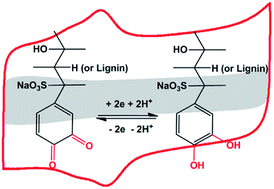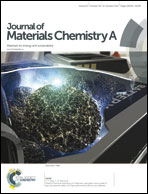A metal-free and flexible supercapacitor based on redox-active lignosulfonate functionalized graphene hydrogels†
Abstract
Emerging flexible supercapacitors have motivated tremendous research interest in portable energy devices. However, challenges still exist in the pursuit of cheap and renewable electrode materials. Herein, a metal-free and flexible supercapacitor was fabricated based on lignosulfonate functionalized graphene hydrogels (LS-GHs). The supercapacitor shows comparable or even higher performance than reported transition metal based pseudocapacitive supercapacitors, which can be attributed to the reversible redox charge transfer of quinone groups in lignin. It presents an impressive specific capacitance of 432 F g−1 in an aqueous electrolyte, which is nearly 2 times higher than that of a pure graphene hydrogel (238 F g−1). Moreover, the device exhibits high rate capability (81.0% capacitance retention at 20 A g−1) and cycling stability (90.0% capacitance retention over 10 000 cycles). The resulting LS-GH electrodes are further fabricated into a flexible solid-state supercapacitor using H2SO4–polyvinyl alcohol (PVA) gel as the electrolyte. The integrated flexible device not only maintains high capacitive performances (408 F g−1 at 1 A g−1, 75.4% capacitance retention at 20 A g−1 and 84.0% capacitance retention over 10 000 cycles), but also exhibits excellent mechanical flexibility. This work paves the way to develop flexible energy devices based on metal-free, renewable and low-cost biomass resources.



 Please wait while we load your content...
Please wait while we load your content...